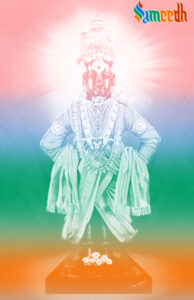Lord Vitthal, also known as Vithoba or Panduranga, is a manifestation of Lord Krushna and a highly revered deity in Hinduism. The worship of Vitthal is particularly popular in the state of Maharashtra, India.

Lord Vitthal is often depicted as a dark-skinned deity, standing with a conch shell (shankha) and a discus (chakra) in his upper hands, and a lotus flower (padma) and a mace (gada) in his lower hands. He is sometimes shown standing on a brick, holding a tambourine (khadga) in one hand.
The most famous temple dedicated to Lord Vithal is the Vitthal Rukmini Temple in Pandharpur. Devotees from various walks of life, known as Varkaris, undertake an annual pilgrimage, known as the Pandharpur Wari, to express their profound devotion. The worship of Lord Vithal emphasizes a personal and emotional connection between the deity and the devotee, transcending societal distinctions. Abhangas, devotional songs, composed by saint poets like Sant Tukaram and Sant Namdev, play a crucial role in expressing the deep love and devotion towards Vitthal.
In the Hindu tradition, Lord Vishnu is believed to incarnate in various forms (avatars) to restore cosmic order and protect dharma (righteousness). Lord Vithal is considered one such manifestation of Lord Vishnu.
Lord Vitthal and Rukmini Story
According to the Puranas, Lord Vitthal is considered an incarnation of Lord Krushna, who is an avatar of Lord Vishnu. The story involving Rukmini and Lord Vituhal is closely associated with the town of Pandharpur in Maharashtra, where the Vitthal Rukmini Temple is located.
Rukmini, the daughter of King Bhishmaka, was deeply in love with Lord Krushna. However, she had not seen Krushna in person, and the tales of his divine exploits had captured her heart. Despite being arranged to marry Shishupala, a prince with royal lineage, Rukmini’s heart belonged to Krushna.
Rukmini, in consultation with her confidante and companion, decided to send a message to Krushna expressing her love and requesting his intervention. She wrote a letter expressing her desire to marry him and sought his help in eloping with her. The letter, carried by a Brahmin messenger named Sunanda, reached Krushna in Dwarka.
On the day of her wedding to Shishupala, Rukmini approached the temple of Amba Bhavani to pray for Lord Krushna’s intervention. Krushna, moved by Rukmini’s devotion, appeared at the temple and, in a swift move, took Rukmini with him on his chariot.
The divine couple reached the town of Pandharpur, where they are believed to reside eternally in the form of Lord Vithal and Rukmini. The Vitthal Rukmini Temple in Pandharpur is dedicated to this divine union.
The love story of Rukmini and Lord Vitthal symbolizes the pure and selfless devotion of a devotee towards the divine. The town of Pandharpur, with its annual pilgrimage known as the Pandharpur Wari, attracts millions of devotees who come to express their deep love and devotion to Lord Vitthal and Rukmini. The traditions and festivals associated with Lord Vitthal in Pandharpur are deeply rooted in the cultural and religious fabric of Maharashtra.
The worship of Lord Vitthal represents a universal path of devotion, emphasizing simplicity, sincerity, and an intimate connection with the divine.